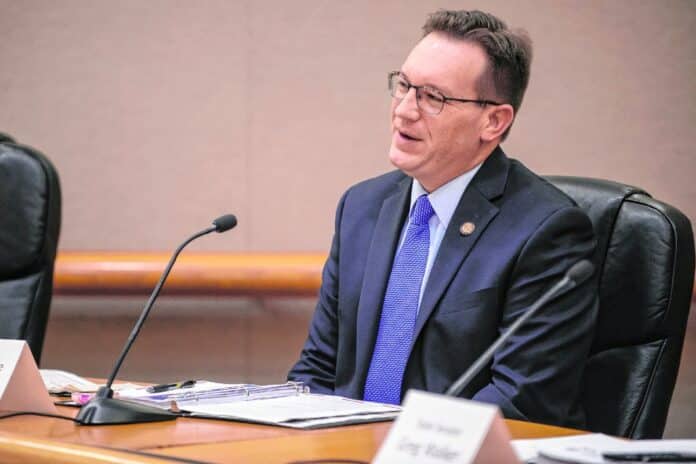
More than 170 public school districts, including Bartholomew Consolidated School Corp., have adopted resolutions opposing bills in the Indiana General Assembly that propose private school voucher programs, as well as new education scholarship accounts (ESAs) with public funds for non-public schools.
But with the Indiana General Assembly winding down quickly, it’s unclear how many state lawmakers will hear the objections from the school districts.
House Bill 1005, co-authored by State Rep. Ryan Lauer, R-Columbus, passed the House 61-38 in mid-February and was assigned to the Senate’s Education and Career Development Committee, according to the Indiana General Assembly website. Committee chairman Sen. Jeff Raatz, R-Richmond, told reporters there’s no need for his committee to hear the bill since the ideas have already received a public hearing.
But Raatz also revealed that items from HB 1005 have been amended into the House Budget Bill (HB 1001).
“Instead of providing items for public testimony, they were rolled into the budget bill itself,” BCSC superintendent Jim Roberts said. “That makes it much harder to address those items in a public way.”
At this time, the only public testimony allowed on the school choice bill will be in regard to the House Budget bill at this point, according to Sen. Greg Walker, R-Columbus.
“When there is a public reading for the budget, that will be, by default, the only public meeting remaining for the school choice bill,” Walker said.
Since the two-year budget is so large, it will be up to Senate Appropriations Committee chairman Ryan Mishler, R-Bremen, to decide whether time will be set aside specifically to discuss school choice and ESAs while the budget is debated, Walker said.
But Roberts doubts Mishler will allow that to happen, because the pieces that made up HB 1005 are just a small part of a massive $36 billion biennial budget.
“When compared to the whole, I think the chances of those pieces being broken out specifically, and leading to dialogue at any level, is slim,” Roberts said.
One recent effort to provide public testimony on the elements of HB 1005 did not turn out well for school choice opponents.
On March 25, the Senate’s subcommittee on school funding held a hearing to seek input on how Indiana should spend more than $15 billion in public education funding over the next two years.
More than 50 people, including school administrators, showed up to voice their concerns on a variety of education issues that include voucher expansion and education scholarship accounts. Due to the coronavirus, those who gave testimony were kept in a separate room from lawmakers, with communication only possible through video conferencing, a representative of the Indiana Legislative Services Agency said.
Since no specific start time for the subcommittee hearing was given, many who gave testimony were forced to wait for several hours Members of the public who spoke critically of school voucher expansion had their views challenged by subcommittee members, who took no action when the 5½ hour meeting ended.
But both Walker and Lauer say they’ve heard from many of their constituents directly on the matter. More public testimony will likely be heard in committee when the bill is sent back to the House to reconcile changes made in the Senate, Lauer said.
However, as of the end of March, the Senate had not unveiled any revisions that would require reconciliation conferences, according to the Associated Press.
Lauer denied an allegation in the BCSC resolution that states most families who benefit from school choice scholarships and Education Savings Accounts (ESAs) would be “relatively affluent,” while the proposed budget under HB 1001 would limit funding for “public schools that serve students from poverty.”
“The statistics show very clearly that 70% of kids who are on the voucher programs today are on free or reduced lunches,” Lauer said.
Roberts responded by saying children from low-income families were always intended to be the beneficiaries when the voucher program was introduced in 2011. But over time, the parameters have greatly changed to the point that most of the dollars from HB 1005 will go to families who have already made the choice of a private school, the BCSC superintendent said.
As the provisions of HB 1005 currently stand, the bill will allow a family with a six-figure salary to qualify for the program, the superintendent said.
The proposed House budget increases spending by $500 million on public education, with $2.5 million more for the Bartholomew Consolidated schools (over two years), Lauer said.
“That’s true,” Roberts said. “Things cost more every year, people tend to get some type of raise in their jobs, and we’re hoping we get enough to just keep up with inflation whenever legislators provide more dollars.”
With the slice of the pie that funds K-12 education in Indiana now being divided among many pieces, the most troubling issue with HB 1005 is the discrepancy at the percentage of the increase of dollars to non-public schools, Roberts said.
“Traditional public schools have about 94% of the students in the state of Indiana, but the percentage of our increase is not in double-digits,” the superintendent said. “However, there are double-digit increases for things such as private school vouchers and the proposed education savings account.”
Other objections raised by the BCSC resolution is that non-public schools are not accountable to taxpayers for the use of public funds. In addition, there’s a provision that would also allow the use of up to $26,000 of “unspent, tax deductible education savings account funds” to pay a child’s college tuition.
“That’s getting beyond school choice,” said Roberts, who said that provision actually gives families a financial incentive to withdraw from public schools.
However, Lauer maintains eligible students for ESAs would be those who have disabilities, are from active military families or are foster children.
The Columbus lawmaker also says his support boils down to allowing parents and kids to choose the best education for their circumstances. While Lauer says Bartholomew County is blessed with good public schools, there are a number of Indiana communities who are not, the lawmaker said.
“I believe government is incapable of making the best choice for your kids,” Lauer said. “Parents should make that decision.”
Lauer expressed disappointment in the BCSC resolution, adding that not one school board member has called him to voice their objections. The state representative also said he’d like to see a resolution from the BCSC school board to freeze funding, so they could pay their teachers more.
He also accused BCSC and other school districts of using the same resolution.
“What I read is that the Indiana School Boards Association lobbied every school board across the state to pass the same resolution,” Lauer said.
But the BCSC resolution was composed locally, Roberts insisted, with language targeted more toward specific bills that the association’s draft.
“So for Rep. Lauer to say (both are the same resolution), he’s either not read either of them closely – or at least he hasn’t read ours closely,” Roberts said.
Although it’s now much harder to specifically debate the provisions of HB 1005 that were placed within the budget, Roberts says he’s hopeful the Indiana Senate has paid attention to the more than 170 public school districts who have denounced it.
A related bill that pertains to choice scholarships for foster children (SB 413) passed the Senate with a 32-15 vote, and is now before the House. However, Senate Bill 412, which would establish an education scholarship account program with eligibility for students with disabilities and those in foster care, has not moved from the Senate Appropriations committee since Feb. 11.




